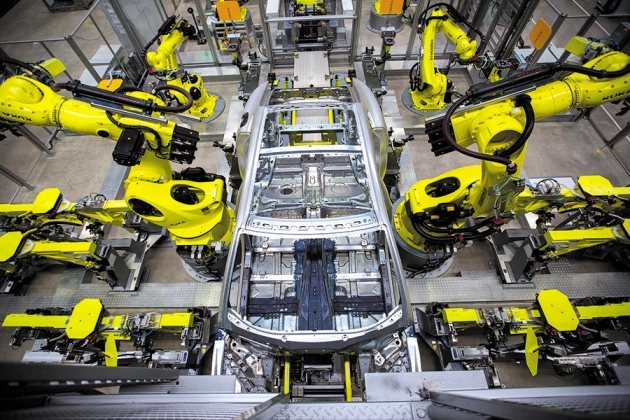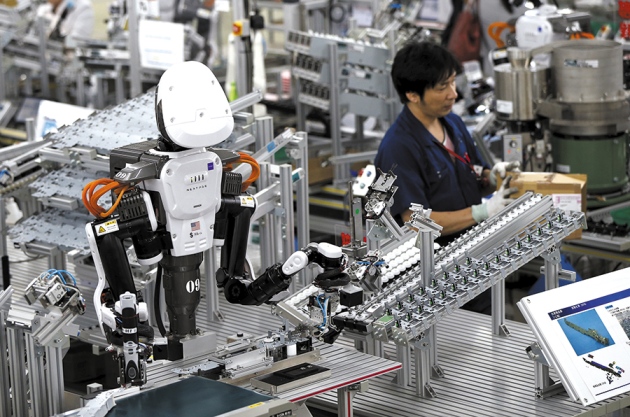Source: Nature magazine
Manufacturing is getting smart. Companies are increasingly using sensors and wireless technologies to capture data at all stages of a product’s life. These range from material properties and the temperatures and vibrations of equipment to the logistics of supply chains and customer details. Truck engines beam back data on speed, fuel consumption and oil temperature to manufacturers and fleet operators. Optical scanners are used to spot defects in printed electronics circuits1.
Robotic welders are making manufacturing increasingly smart.

But big data is a long way from transforming manufacturing. Leading industries — computing, energy and aircraft and semiconductor manufacturing — face data gaps. Most companies do not know what to do with the data they have, let alone how to interpret them to improve their processes and products. Businesses compete and usually operate in isolation. They lack software and modelling systems to analyse data.
Yet smart manufacturing can make industry more efficient, profitable and sustainable. Minimizing the distances over which products and components are transported reduces costs — financial and environmental. Computer modelling can identify risks and pinch points. It can, for example, anticipate impacts from deliveries delayed by extreme weather, a situation that affect the electronics industry after Thailand’s major floods in 2011. Similarly, predicting when a car component is likely to fail and fixing it swiftly avoids expensive recalls and litigation. In industries with low yields, such as semiconductor manufacturing, halving production errors substantially increases profits.
Shifting entire business sectors around the globe is daunting. It raises many technical, business and policy issues and will fundamentally alter the shapes of industries. Some forms of production will become more distributed, others centralized. Manufacturers will increasingly adopt business models akin to that of Uber, the ride-hailing company. More clothing and furniture could be customized and manufactured locally, rather than shipped around the world. Personalized drugs or medical implants will be 3D printed at the hospital.
Production lines will need to be shared. Instead of a company owning all the equipment it ever needs — which is expensive and inefficient — it will sometimes lease manufacturing capacity elsewhere. For example, a car company might buy time at a wheelchair factory to add seats and handles for a disabled customer. Artificial intelligence, robots and autonomous vehicles will make it easier to share production lines and technologies.

Robotic arms work on a Porsche body frame.
But industry is unprepared for the incoming changes. Data science is rarely taught in engineering or business degrees. Companies do not know what to measure or when. Information is stored inconveniently for modelling — engine temperatures and mileage in separate databases, for example. Companies are hesitant to invest in unproven technologies and business models.
Achieving progress requires closer collaboration between researchers and industry. Online platforms are needed on which companies can post their industrial problems and find experts to solve them. Physical spaces and cyberlaboratories should be set up for academic and industrial developers to work on solutions together. Policies should enable secure data sharing.
Five gaps in innovation
Manufacturers need practical guidance. Most academic research is tangential to corporate needs. Academics push technological frontiers, from artificial intelligence to deep learning, without considering how they will be applied. Manufacturers want to know what types of data to sample, which sensors to use and where along the production line to install them. For example, to improve ceramic-material quality, which is challenging to attain, a manufacturer might want to monitor the performance of machinery as well as the structure of the product. Research is needed to determine the best configurations of sensors. Five gaps in smart manufacturing innovation need to be filled.
Adopt strategies. Smart manufacturing systems must evolve as information is gathered. At first, sensors would monitor the states of existing equipment. As new needs for quality and efficiency emerge, more sensors can be added to follow the most useful parameters. The semiconductor industry, for example, has improved the quality of its wafers by tracking and adjusting its process settings.
Improve data collection, use and sharing. Here, most companies lack experience. Some mistakenly believe that their databases are too big for analysis. Others fret over organizational and legal aspects of data use. And quality matters more than quantity. Noisy or irregularly sampled measurements are of little use. The frequency at which data are collected and how long they are stored needs to be determined. High volumes of rapid measurements cost more to store, but long-term data are essential for modelling. Appropriate periods for averaging need to be determined. Machine vibrations must be followed on timescales of seconds or less, whereas temperatures can be averaged over 10 minutes or longer periods. Protocols are needed to address data privacy, protection and security.
Design predictive models. Corporations want to know that a new product will meet customer expectations before they manufacture it. A car company may analyse past and current sales, customer behaviour and other data to supply dealerships with the most desirable car models. Factories want assurance that changing a machine tool will not affect the quality of their product.
Study general predictive models. Models need to be able to handle uncertainties such as degrading equipment or data errors from streaming failures or faulty sensors. A missing or erroneous data point could cause costly disruption to systems that produce one-of-a-kind products, such as medical implants.
Connect factories and control processes. Current software for controlling production processes and resource planning, such as the widely used SAP package, will face challenges in a more dynamic and open manufacturing environment that straddles many different producers. Most software is designed for use by a single corporation. Research is needed to ensure that such systems can operate together through open interfaces and universal standards. New programmes suited to cloud computing may be required, and could take inspiration from complexity in the natural world — such as the genome, bird flocks and the human immune system. Real-world experimentation is also needed, through prototypes, test beds and virtual and augmented reality.

Humans and robots work alongside each other at Glory in Kazo, Japan, a maker of automatic charge dispensers.
Energy and health care
Accomplishing all this requires intellectual effort, money and better collaboration between industry, academia and government. In the past five years, several regional initiatives for smart manufacturing have been set up. But their goals are mainly directed by industry, and the more general aspects of data and modelling receive little attention.
One such initiative is the US-based Smart Manufacturing Leadership Coalition, launched in 2012. Companies pay a fee to join and members determine the research agenda and goals — one being an open-access platform for collecting plant-level data and systems.
Germany’s Plattform Industrie 4.0 (part of the government’s High-Tech Strategy 2020) promotes the computerization of its industrial base, for example using machinery that anticipates failures and triggers maintenance processes autonomously. The European Union is investing [euro]7 billion (US$7.6 billion) by 2020 in Factories of the Future, a public–private partnership to develop a blueprint for smart manufacturing. Japan and China have similar programmes.
I suggest that energy and health care should be the first foci for deep collaboration, because they have the greatest societal impact. For example, the life cycles and manufacture of wind turbines need rethinking. Their components — gear boxes, generators, blades, towers and kilometres of cables — are built in conventional ways from materials (mainly metals) sourced from and shipped around the globe. After 20 years of use, turbines may be scrapped. Smart processes should be designed to make and decommission them more sustainably. New technologies such as additive manufacturing should be explored. The smart manufacturing initiatives mentioned here should work with global initiatives such as the Breakthrough Energy Coalition to promote renewable energy sources, and the US Cancer Moonshot initiative that seeks clinical and technological advances in cancer treatment.
Lessons can be learned from precedents set in the 1990s2. Progress in intelligent manufacturing was limited by several factors, including the inability to see the value of large-scale international collaboration, lack of governmental endorsement, and different management styles of corporations across the globe. In 1995, Japan launched its Intelligent Manufacturing System to connect major national manufacturing industries and universities with global partners. The US government did not endorse the collaborations. Meanwhile, a consortium of US companies established the Next Generation Manufacturing Systems programme, which linked with Japan’s iniative and others in Asia and Europe. Trust, will, conviction and policies are now needed for similar endeavours to succeed.
New platforms
Three practical steps need to be taken to plug knowledge gaps and enable smart manufacturing.
Establish networks to define problems. Consortia of private corporations, foundations, academia and governmental entities should set up online forums where practitioners and researchers can discuss, develop and publish specifications of emerging industrial problems. Many corporations have internal sites for soliciting ideas. Ways to integrate services and manufacturing processes would be worthy topics to start with. Different modes of operations and financial support ranging from crowdsourcing to licences and fees for service should be considered.
Develop platforms for modelling, sharing and innovation. As the world becomes more complex, a gap is opening up between those who understand industrial needs and those with the skills to model and solve problems. Online or physical spaces should be provided by consortia involving industry, academia and government, in which experts and practitioners can interact to develop technical solutions and models. These platforms might mirror ‘maker spaces’ or the innovation hubs promoted by the US National Science Foundation and companies that do research, such as SRI International, Procter & Gamble and Google.
Parties must overcome issues of trust and reticence to reveal information. Collaborative structures should support transparency and openness as well as diverse ideas and cultures. It is essential that small and medium enterprises are involved. The consortia should develop schemes to allow modellers to access private data.
Enact smart manufacturing policies. Although industry will drive much of the shift to smart manufacturing because it makes business sense, governments should fill gaps or support areas too risky for private investment. For example, a 2016 report3 by the Information & Technology Innovation Foundation, a policy think tank in Washington DC, called on the US Congress to expand federal resources for training and to help small- and medium-sized businesses to adopt smart manufacturing technologies. Incentives might include an investment tax credit for updating machinery and equipment.
By acting as one to deliver the tools, industry, government and academia can make the next industrial revolution a reality.
Nature 544, 23–25 (06 April 2017) | doi:10.1038/544023a

